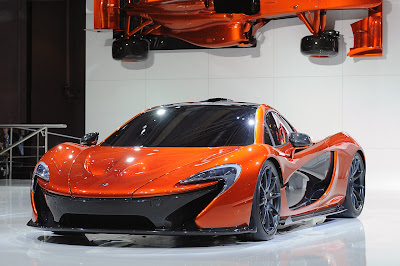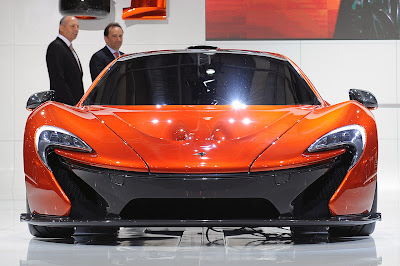McLaren took the wraps off its upcoming P1 supercar nearly five months ago at the Paris Motor Show, but the automaker refused to release details about its interior, powerplant or performance – those juicy details would all have to wait.
Yet after a private showing in New York, followed by another exclusive event in Beverly Hills, McLaren began to slowly trickle out information about the P1's instrument cluster and passenger cabin, before finally disclosing its 903 horsepower hybrid powerplant earlier this month.
Finally, after much speculation, McLaren has revealed the last piece of the puzzle and announced its tested performance figures. The 100 km/h benchmark (62 mph) falls in "less than three seconds" while the 200 km/h barrier (124 mph) is shattered in "under seven seconds." Lastly, the rear-wheel drive P1 will hit 300 km/h (186 mph) in "no more than 17 seconds" (an impressive 11 seconds faster than its legendary McLaren F1). Those blistering numbers put the P1 among a very small and elite group, with members like Bugatti, Koenigsegg and Hennessey – the fastest road cars on the planet.
If you are wondering how much it costs to embarrass a Ferrari, McLaren also broke its pricing embargo today. Base price, in the United States, is a cool $1,150,000.
McLaren Automotive announces performance figures for the McLaren P1™
- Instant Power Assist System (IPAS) provides astonishing acceleration: 0 to 300 km/h (186 mph) in less than 17 seconds, more than 35% faster than the legendary McLaren F1
- Top speed electronically limited to 350 km/h (218 mph)
- The production number has been limited to 375 units
- Base price in the US is $1,150,000
- Fully equipped as standard for road and track use
- Production model is almost unchanged from the original design study
McLaren Automotive has announced the final numbers, images and information relating to the McLaren P1™ ahead of a global reveal in just a few days at the 83rd International Geneva Motor Show.
The race-inspired Instant Power Assist System (IPAS) gives the McLaren P1™ astonishing performance. Zero to 100km/h (62 mph) will take less than 3 seconds, zero to 200 km/h (124 mph) in under 7 seconds, and zero to 300 km/h (186 mph) will be achieved in no more than 17 seconds. This is 11 seconds faster than the legendary McLaren F1 road car. Top speed is electronically limited to 350 km/h (218 mph).
The McLaren P1™ has translated to production form with very little changed from the prototype shown at the Paris Auto Show. In fact just one change-the addition of LTR ducts ahead of each of the front wheels to further aid cooling and optimise downforce.
McLaren has announced a global production number of just 375 units – a figure that will ensure the McLaren P1™ will remain a rarity.
McLaren has also announced that the car will have a base price of $1,150,000 in the US and have a specification that fully equips the car for both road and track use. The company prides itself on designing performance cars that their owners can use regularly so the McLaren P1™ comes standard with a comprehensive specification list. The options list is limited to only bespoke content that a customer might wish to add through McLaren Special Operations, and fitted luggage.
As already announced, the McLaren P1™ will have the combined force of two highly-efficient powerplants, offering the optimum mix of superb throttle response, day-to-day drivability and top speed. A mid-mounted 3.8-litre twin-turbo V8 petrol engine is substantially enhanced featuring, for example, larger turbochargers and a highly effective electric motor, to give a combined output of 916PS (903 bhp) and a maximum torque figure of 900Nm. This ensures instantaneous throttle response through the rev range, more akin to a naturally aspirated engine. Emissions of less than 200g/km on the EU combined cycle are reduced to zero in full electric drive mode, while the Formula 1-derived DRS and IPAS technologies offer an increase in straight-line speed and an instant boost of power.
The tires fitted to the McLaren P1™ are specially developed P Zero Corsas, which have been developed with McLaren's technology partner, Pirelli. The team at Pirelli has been involved throughout the entire development program, and this has seen the tire testing phase integrated into the schedule, as a key performance component. The final compound and construction has been developed and optimised during testing, and the end result is a tire that is finely tuned specifically to the performance and handling characteristics.
To rein in the power produced by the twin powerplants, the McLaren P1™ is designed to offer braking performance more associated with a GT3 or sports racing car. Developed by McLaren's Formula 1 partner Akebono, the system features a new type of carbon ceramic disc, which has previously seen service in space, but never before used on a road car. Stronger than conventional carbon ceramic, the material dissipates heat more effectively, giving the highly efficient braking system exceptional stopping and cooling capability. The system also boasts significantly reduced weight, and a bespoke ceramic layer coats both friction surfaces to give an attractive mirrored finish.
The car can also be driven solely in electric mode. In city driving, with an average speed of 30 mph, this could mean up to a 20km range. More than enough for an owner to enter, for example, a city center Zero Emissions Zone, have dinner and return home.
Articles Source : Autoblog






No comments:
Post a Comment